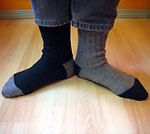I haven’t undertaken a scientific study, but it doesn’t seem like finishing is very popular. Lots of people love to knit, but not so many people like to sew up what they’ve knit. I can’t tell you how many times I’ve heard about “. . . that sweater that’s sitting in the back of my closet, just waiting for me to put it together. Sigh. If only I didn’t hate seaming so much.” The number of inquiries I’ve received about whether Halfdome can be knit in the round seems to back this up.
Some of this is understandable. Weaving in yarn ends certainly isn’t very exciting; for me, it ranks somewhere between scooping out the cat box and flossing my teeth. I’ve even considered designing an H.P. Lovecraft-inspired sweater that achieves its tentacled effect by having all of its yarn ends left dangling. No, yarn ends are no fun at all.
Seaming, on the other hand, is a glorious activity. The pleasure of watching four (or five (or six)) pieces of knitting come together into a perfect whole is deep and lasting. And those pieces were flat! And now they’re a shaped garment! Holy crap! How much do I love seaming? Let us count the ways.
First, we have the tapestry needle. There aren’t a lot of wholly perfect objects in the world——well, not too many artificial ones——but the tapestry needle is one of them. Two inches of pure molded steel, the tapestry needle sits more comfortably between your thumb and index finger than any other piece of metal. It’s tapered just enough to pass between two strands of yarn, but not so much that it splits everything it touches. And it never pierces your skin.

Here it is doing my favorite finishing activity: mattress stitch. That strand of yarn is the bar between an edge stitch and its neighbor. Slipping that needle between those two stitches and teasing out that bar is strangely satisfying, like removing a splinter from underneath your fingernail. It’s always a little reticent at first, but once it’s out it’s out.And once you’ve pulled the needle through, what was once the bottom end of a mere knit stitch is now a link in the chain that will hold your sweater together. See what happens when we go back and forth a few times?

Now comes the really amazing part. See how I’m about to pull on that yarn there? Well, here I go:

Did you see that? That seam has disappeared! It’s, like, totally gone! And when you do mattress stitch, you get to do this over and over. Am I the only knitter who thinks this is fun? No way. Admit it: mattress stitch is a hoot and a half.
Like scrambled eggs, mattress stitch is one of those things that I wonder how anyone came up with. It’s not exactly obvious that if you work a strand of yarn between alternating edge stitches you get a seam that evaporates right before your eyes, but there it is. When two pieces of knitting are worked together this way, it’s like they were destined to be joined. Who knew?
Not all seaming is this mind-blowing, of course. Joining sleeve caps to their respective sleeve holes isn’t anywhere near as satisfying (or as easy), and shoulder seams call for a more subtle hand than side seams and sleeve seams . . . but have you ever tried grafting? Oh man! Any day I get to use kitchener stitch is a day that was worth getting out of bed for! When I do sock toes, I just——
Ahem. Right. I’m going to shut up now.

 My last four sweaters have been zippered cardigans. Two of those were for friends. The third was
My last four sweaters have been zippered cardigans. Two of those were for friends. The third was 


